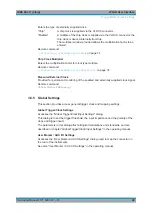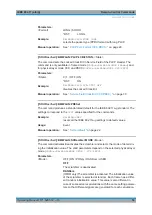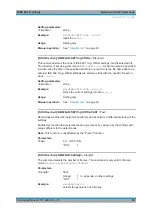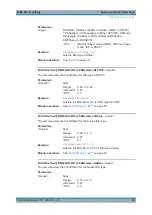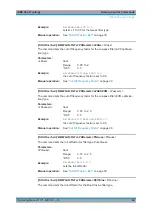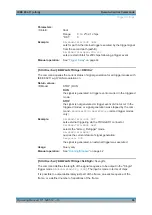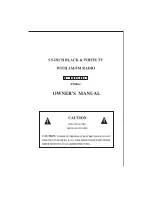
Remote-Control Commands
IEEE 802.11 (a/b/g)
58
Operating Manual 1171.5283.12 ─ 18
[:SOURce<hw>]:BB:WLAN:STATe
<State>
Activates the standard and deactivates all the other digital standards and digital modu-
lation modes in the same path.
Parameters:
<State>
0 | 1 | OFF | ON
*RST:
0
Example:
SOURce1:BB:WLAN:STATe ON
Manual operation:
See
[:SOURce<hw>]:BB:WLAN:TDWindowing:STATe
<State>
The command activates/deactivates the time domain windowing. Time domain window-
ing is a method to influence the spectral characteristics of the signal, which is not stipu-
lated by the standard. However, it does not replace oversampling and subsequent sig-
nal filtering. The command is only available for physical layer mode OFDM
(
SOURce:BB:WLAN:MODE OFDM
).
Parameters:
<State>
0 | 1 | OFF | ON
*RST:
OFF
Example:
BB:WLAN:TDW:STAT OFF
deactivates the time domain windowing.
Manual operation:
See
" Time Domain Windowing Active "
[:SOURce<hw>]:BB:WLAN:TTIMe
<Ttime>
The command sets the transition time. The transition time defines the overlap range of
two OFDM symbols when time domain windowing is active. At a setting of 100 ns, one
sample overlaps. This command is only available in physical layer mode OFDM
(
SOURce:BB:WLAN:MODE OFDM
) and with active time domain windowing
(
SOURce:BB:WLAN:TDWindowing:STATe ON
).
Parameters:
<Ttime>
float
Range:
0 to 1E-6
*RST:
100E-9
Example:
BB:WLAN:TTIM 10 ns
sets a transition time of 10 ns.
Manual operation:
See
General Commands





